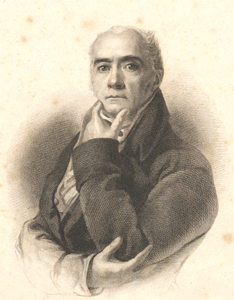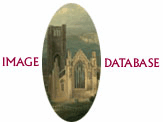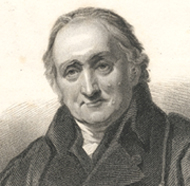|
|
Home | Corson
Collection | Biography | Works | Image
Collection | Recent
Publications | Correspondence | Forthcoming
Events | Links | E-texts | Contact
Sir Henry Raeburn (1756-1823)
 The
most prominent portrait painter of his day, Raeburn was born in
the Stockbridge area of Edinburgh on 4 March 1756. He lost his
father, a mill owner, at an early age, was raised by an older brother,
and educated at Heriot's Hospital. In 1772 he was apprenticed to
the jeweller James Gilliland but began painting water-colour miniatures
of his friends. He soon attracted the attention of the city's leading
portraitist, David Martin. With guidance from Martin, Raeburn turned
to painting in oil and began to develop his personal style. In
1778, he married a wealthy widow of independent means, whose dowry
permitted him to devote himself entirely to painting. Through the
marriage, he also acquired the Deanhaugh Estate in Stockbridge.
He was later to purchase the neighbouring St. Bernard's estate
and to amass a considerable fortune by feuing both for building
the Stockbridge extension of Edinburgh's New Town. In 1784 he travelled
to London where he met Sir Joshua Reynolds whose style was to exert
a great influence upon him. On Reynolds's advice, he spent the
following two years studying in Italy. Raeburn returned to Edinburgh
in 1787, set up a studio in George Street, and rapidly established
himself as the leading portraitist of Edinburgh society. He was
to paint many of the most prominent Scots of the days, gradually
developing from bust-sized figures to full length portraits. His
reputation spread beyond Edinburgh and he became a member of the
Royal Academy in 1815. He was knighted by King George IV during
his visit to Scotland in 1822 and, shortly before his death in
1823, was appointed His Majesty's Limner for Scotland. Alongside Sir
David Wilkie, Raeburn is considered the founder of the 'Scottish
School' of painting. The
most prominent portrait painter of his day, Raeburn was born in
the Stockbridge area of Edinburgh on 4 March 1756. He lost his
father, a mill owner, at an early age, was raised by an older brother,
and educated at Heriot's Hospital. In 1772 he was apprenticed to
the jeweller James Gilliland but began painting water-colour miniatures
of his friends. He soon attracted the attention of the city's leading
portraitist, David Martin. With guidance from Martin, Raeburn turned
to painting in oil and began to develop his personal style. In
1778, he married a wealthy widow of independent means, whose dowry
permitted him to devote himself entirely to painting. Through the
marriage, he also acquired the Deanhaugh Estate in Stockbridge.
He was later to purchase the neighbouring St. Bernard's estate
and to amass a considerable fortune by feuing both for building
the Stockbridge extension of Edinburgh's New Town. In 1784 he travelled
to London where he met Sir Joshua Reynolds whose style was to exert
a great influence upon him. On Reynolds's advice, he spent the
following two years studying in Italy. Raeburn returned to Edinburgh
in 1787, set up a studio in George Street, and rapidly established
himself as the leading portraitist of Edinburgh society. He was
to paint many of the most prominent Scots of the days, gradually
developing from bust-sized figures to full length portraits. His
reputation spread beyond Edinburgh and he became a member of the
Royal Academy in 1815. He was knighted by King George IV during
his visit to Scotland in 1822 and, shortly before his death in
1823, was appointed His Majesty's Limner for Scotland. Alongside Sir
David Wilkie, Raeburn is considered the founder of the 'Scottish
School' of painting.
Raeburn painted over 700 portraits, including
four of Sir Walter Scott in 1808, 1809,
and 1823 (twice).
These are discussed on separate pages. Amongst Raeburn's
other most celebrated likenesses are those of Mrs James Campbell,
Sir John Sinclair, Lord Newton, and Alexander Adam. Today
he is perhaps best-known for his much reproduced image of The
Reverend Robert Walker Skating on Duddingston Loch.
Click on the thumbnail to the right too see an engraving
by Samuel Freeman of
Raeburn's portrait of Dr Alexander Adam, Rector of the High
School of Edinburgh when Scott attended it (see School
and University).
|
|
Links
For further information on Raeburn and images of his work, please
consult the following sites:
Bibliography
- Bryan, Michael. Dictionary of Painters
and Engravers: Biographical and Critical. New edn, rev.
and enl. by Robert Edmund Graves (London: G. Bell, 1886-1889)
- Dictionary of National Biography (London:
Oxford University Press, 1921)
- McEwan, Peter J. M. Dictionary
of Scottish Art & Architecture (Woodbridge, Suffolk:
Antique Collectors' Club, c1994)
- Redgrave, Samuel. A Dictionary
of Artists of the English School: Painters, Sculptors, Architects
with Notices of their Lives and Work (London: G. Bell
and Sons, 1878)
- Russell, Francis. Portraits
of Sir Walter Scott: A Study of Romantic Portraiture (London:
The Author, 1987)
Back to Index

Last updated: 19-Apr-2005
© Edinburgh University Library
|
|

 The
most prominent portrait painter of his day, Raeburn was born in
the Stockbridge area of Edinburgh on 4 March 1756. He lost his
father, a mill owner, at an early age, was raised by an older brother,
and educated at Heriot's Hospital. In 1772 he was apprenticed to
the jeweller James Gilliland but began painting water-colour miniatures
of his friends. He soon attracted the attention of the city's leading
portraitist, David Martin. With guidance from Martin, Raeburn turned
to painting in oil and began to develop his personal style. In
1778, he married a wealthy widow of independent means, whose dowry
permitted him to devote himself entirely to painting. Through the
marriage, he also acquired the Deanhaugh Estate in Stockbridge.
He was later to purchase the neighbouring St. Bernard's estate
and to amass a considerable fortune by feuing both for building
the Stockbridge extension of Edinburgh's New Town. In 1784 he travelled
to London where he met Sir Joshua Reynolds whose style was to exert
a great influence upon him. On Reynolds's advice, he spent the
following two years studying in Italy. Raeburn returned to Edinburgh
in 1787, set up a studio in George Street, and rapidly established
himself as the leading portraitist of Edinburgh society. He was
to paint many of the most prominent Scots of the days, gradually
developing from bust-sized figures to full length portraits. His
reputation spread beyond Edinburgh and he became a member of the
Royal Academy in 1815. He was knighted by King George IV during
his visit to Scotland in 1822 and, shortly before his death in
1823, was appointed His Majesty's Limner for Scotland. Alongside
The
most prominent portrait painter of his day, Raeburn was born in
the Stockbridge area of Edinburgh on 4 March 1756. He lost his
father, a mill owner, at an early age, was raised by an older brother,
and educated at Heriot's Hospital. In 1772 he was apprenticed to
the jeweller James Gilliland but began painting water-colour miniatures
of his friends. He soon attracted the attention of the city's leading
portraitist, David Martin. With guidance from Martin, Raeburn turned
to painting in oil and began to develop his personal style. In
1778, he married a wealthy widow of independent means, whose dowry
permitted him to devote himself entirely to painting. Through the
marriage, he also acquired the Deanhaugh Estate in Stockbridge.
He was later to purchase the neighbouring St. Bernard's estate
and to amass a considerable fortune by feuing both for building
the Stockbridge extension of Edinburgh's New Town. In 1784 he travelled
to London where he met Sir Joshua Reynolds whose style was to exert
a great influence upon him. On Reynolds's advice, he spent the
following two years studying in Italy. Raeburn returned to Edinburgh
in 1787, set up a studio in George Street, and rapidly established
himself as the leading portraitist of Edinburgh society. He was
to paint many of the most prominent Scots of the days, gradually
developing from bust-sized figures to full length portraits. His
reputation spread beyond Edinburgh and he became a member of the
Royal Academy in 1815. He was knighted by King George IV during
his visit to Scotland in 1822 and, shortly before his death in
1823, was appointed His Majesty's Limner for Scotland. Alongside 
